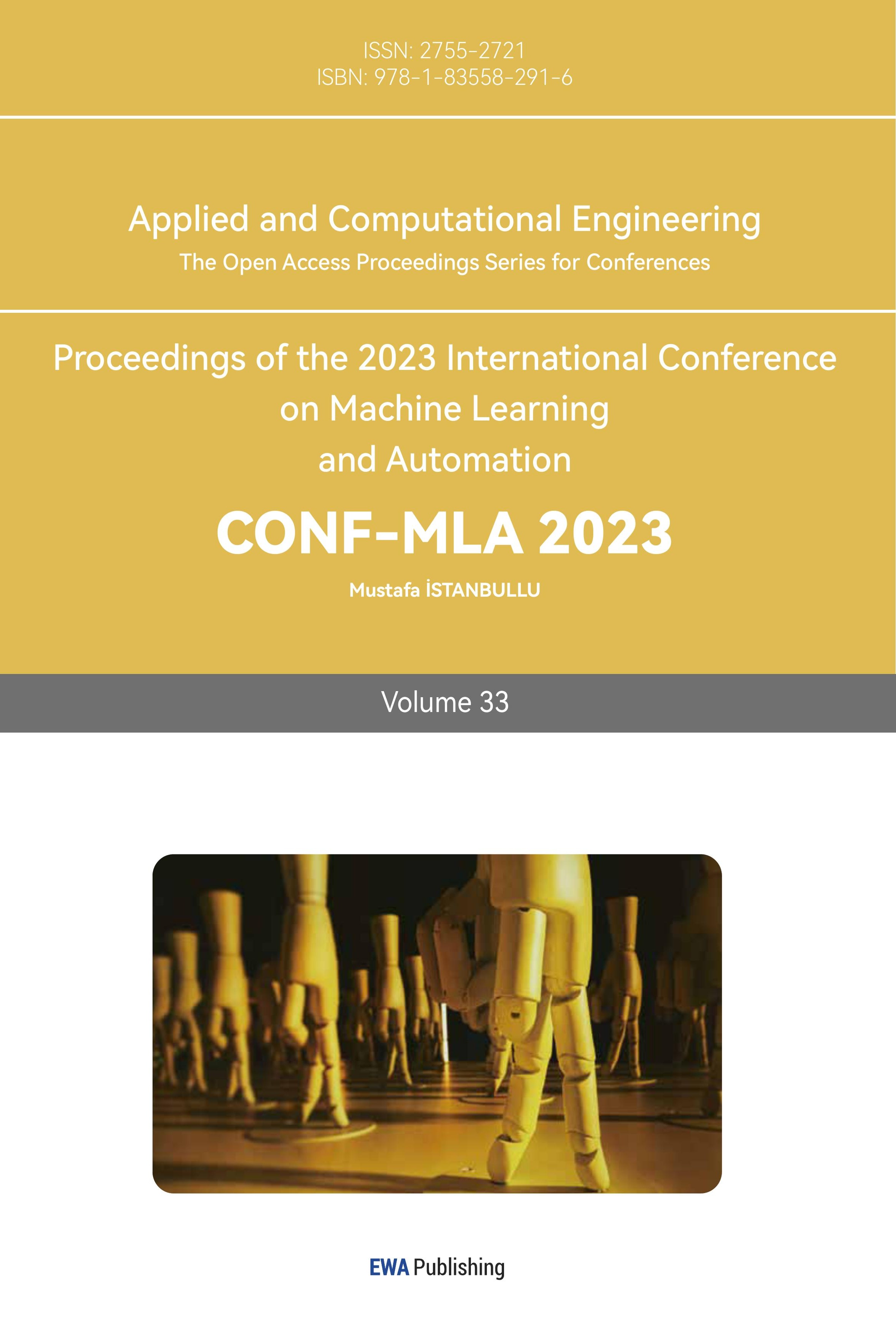References
[1]. A. Ng, (2004)."Feature selection, L1 vs. L2 regularization, and rotational invariance," in Proceedings of the 21st International Conference on Machine Learning (ICML), 04 Proceedings of the twenty-first international conference on Machine learning, Stanford.
[2]. Y. LeCun, Y. Bengio, and G. Hinton. (2015). "Deep learning," Nature, 521 (7553), 436-444.
[3]. Andre Esteva, Brett Kuprel, Roberto A. Novoa et al. (2017).Dermatologist-level classification of skin cancer with deep neural networks. Nature,542(7639),115-118.
[4]. Pranav Rajpurkar, Jeremy Irvin, Kaylie Zhu, et al. (2017). CheXNet: Radiologist-level pneumonia detection on chest x-rays with deep learning.arXiv preprint arXiv: 1711.05225.
[5]. Trevor Hastie, Robert Tibshirani, Jerome Friedman (2009). The Elements of Statistical Learning: Data Mining, Inference, and Prediction. Springer. 33.
[6]. Varun Gulshan, Lily Peng, Marc Coram, Martin C. Stumpe et al. (2016). Development and validation of a deep learning algorithm for detection of diabetic retinopathy in retinal fundus photographs. JAMA,316(22),2402-2410.
[7]. Bishop, C.M. (2006). Pattern Recognition and Machine Learning. Springer. 351.
[8]. Dmitrii Bychkov, Nina Linder, Riku Turkki et al. (2018). Deep learning based tissue analysis predicts outcome in colorectal cancer. Scientific Reports,8(1),1-11.
[9]. Scott M. McKinney, Marc Sieniek, Varun Godbole, et al. (2020). International evaluation of an AI system for breast cancer screening. Nature, 577(7788), 89-94.
[10]. Ryan Poplin, Avinash Varadarajan, Katy Blumer et al. (2018). Prediction of cardiovascular risk factors from retinal fundus photographs via deep learning. Nature Biomedical Engineering,2(3),158-164.
Cite this article
Meng,Q. (2024). Application of machine learning in medicine. Applied and Computational Engineering,33,207-212.
Data availability
The datasets used and/or analyzed during the current study will be available from the authors upon reasonable request.
Disclaimer/Publisher's Note
The statements, opinions and data contained in all publications are solely those of the individual author(s) and contributor(s) and not of EWA Publishing and/or the editor(s). EWA Publishing and/or the editor(s) disclaim responsibility for any injury to people or property resulting from any ideas, methods, instructions or products referred to in the content.
About volume
Volume title: Proceedings of the 2023 International Conference on Machine Learning and Automation
© 2024 by the author(s). Licensee EWA Publishing, Oxford, UK. This article is an open access article distributed under the terms and
conditions of the Creative Commons Attribution (CC BY) license. Authors who
publish this series agree to the following terms:
1. Authors retain copyright and grant the series right of first publication with the work simultaneously licensed under a Creative Commons
Attribution License that allows others to share the work with an acknowledgment of the work's authorship and initial publication in this
series.
2. Authors are able to enter into separate, additional contractual arrangements for the non-exclusive distribution of the series's published
version of the work (e.g., post it to an institutional repository or publish it in a book), with an acknowledgment of its initial
publication in this series.
3. Authors are permitted and encouraged to post their work online (e.g., in institutional repositories or on their website) prior to and
during the submission process, as it can lead to productive exchanges, as well as earlier and greater citation of published work (See
Open access policy for details).
References
[1]. A. Ng, (2004)."Feature selection, L1 vs. L2 regularization, and rotational invariance," in Proceedings of the 21st International Conference on Machine Learning (ICML), 04 Proceedings of the twenty-first international conference on Machine learning, Stanford.
[2]. Y. LeCun, Y. Bengio, and G. Hinton. (2015). "Deep learning," Nature, 521 (7553), 436-444.
[3]. Andre Esteva, Brett Kuprel, Roberto A. Novoa et al. (2017).Dermatologist-level classification of skin cancer with deep neural networks. Nature,542(7639),115-118.
[4]. Pranav Rajpurkar, Jeremy Irvin, Kaylie Zhu, et al. (2017). CheXNet: Radiologist-level pneumonia detection on chest x-rays with deep learning.arXiv preprint arXiv: 1711.05225.
[5]. Trevor Hastie, Robert Tibshirani, Jerome Friedman (2009). The Elements of Statistical Learning: Data Mining, Inference, and Prediction. Springer. 33.
[6]. Varun Gulshan, Lily Peng, Marc Coram, Martin C. Stumpe et al. (2016). Development and validation of a deep learning algorithm for detection of diabetic retinopathy in retinal fundus photographs. JAMA,316(22),2402-2410.
[7]. Bishop, C.M. (2006). Pattern Recognition and Machine Learning. Springer. 351.
[8]. Dmitrii Bychkov, Nina Linder, Riku Turkki et al. (2018). Deep learning based tissue analysis predicts outcome in colorectal cancer. Scientific Reports,8(1),1-11.
[9]. Scott M. McKinney, Marc Sieniek, Varun Godbole, et al. (2020). International evaluation of an AI system for breast cancer screening. Nature, 577(7788), 89-94.
[10]. Ryan Poplin, Avinash Varadarajan, Katy Blumer et al. (2018). Prediction of cardiovascular risk factors from retinal fundus photographs via deep learning. Nature Biomedical Engineering,2(3),158-164.









